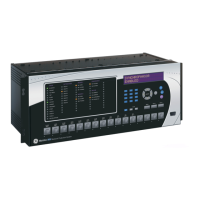GE Multilin N60 Network Stability and Synchrophasor Measurement System 5-215
5 SETTINGS 5.7 CONTROL ELEMENTS
5
The two input arguments are user-configurable as collections of FlexLogic operands using the binary encoding convention.
This allows bringing analog values from remote locations via communication-based inputs/outputs to facilitate telemetry
and other advanced applications. The two values to be added or subtracted should have a common scaling and should be
of the same type. For example, adding voltage and current will not yield meaningful results.
This element is typically applied in conjunction with the digitizer feature.
• 8BIT COMP 1 ARG A0 to 8BIT COMP 1 ARG A7: These settings specify FlexLogic operands that provide an 8-bit
representation of the first argument, A, of the comparator. The
8BIT COMP 1 ARG A0 setting represents the least signifi-
cant bit, while the 8BIT COMP 1 ARG A6 setting represents the most significant bit. The 8BIT COMP 1 ARG A7 setting repre-
sents the sign bit (asserted for negative values). In other words, the following convention is used:
(EQ 5.21)
Care must be taken to avoid race conditions for the used bits (FlexLogic operands). If the 8 bits are not changing simul-
taneously (for example, when some of the bits arrive via contact inputs and the others arrive via direct inputs) a race
condition may occur, leading to severe over- or under-estimation of the resulting 8-bit number. For example, assume
the integer value changes from 15 to 16, i.e. from 00001111 to 00010000, but transiently the A4 bit asserts before the
A3 through A0 bits de-assert. As a result, a value of 00011111, or 31, is produced, resulting in almost 100% overesti-
mation compared to a true value of 16.
To prevent problems, pickup and dropout time delays must be applied to avoid misoperation, or all eight bits must be
configured to change simultaneously (for example, applied to the relay via the same communications).
• BIT COMP 1 ARG B0 to 8BIT COMP 1 ARG B7: These settings specify FlexLogic operands that provide an 8-bit rep-
resentation of the second argument, B, of the comparator. The
8BIT COMP 1 ARG B0 setting represents the least signifi-
cant bit, while the 8BIT COMP 1 ARG B6 setting represents the most significant bit. The 8BIT COMP 1 ARG B7 setting is the
sign bit (asserted for negative values). In other words the following convention is used:
(EQ 5.22)
• 8BIT COMP 1 INPUT MODE: This setting specifies whether a signed or absolute value should be used for comparison
with the pickup threshold. This setting applies to the effective operating signal (that is, either A – B or A + B) and not to
the individual inputs. The figure below illustrates an effective operating characteristic resulting from this setting.
The 8BIT COMP 1 Out actual value, as well as the 8BIT COMP1 BIT0 through 8BIT COMP1 BIT7 FlexLogic operands, are
derived without reference to this setting.
• 8BIT COMP 1 DIRECTION: This setting specifies if the element should operate if the effective operating signal is
above (“Over”) or below (“Under”) the threshold as illustrated in the following figure.
Figure 5–90: OPERATING CHARACTERISTICS OF THE 8-BIT COMPARATOR
A 1–
a
7
2
6
a
6
2
5
a
5
2
4
a
4
2
3
a
3
2
2
a
2
2
1
a
1
2
0
a
0
++++++=
B 1–
b
7
2
6
b
6
2
5
b
5
2
4
b
4
2
3
b
3
2
2
b
2
2
1
b
1
2
0
b
0
++++++=
842740A1.CDR
OPERATING SIGNAL
OPERATING SIGNAL
OPERATING SIGNAL
OPERATING SIGNAL
INPUT MODE = Signed
DIRECTION = Over
INPUT MODE = Absolute
DIRECTION = Over
INPUT MODE = Signed
DIRECTION = Under
INPUT MODE = Absolute
DIRECTION = Under

